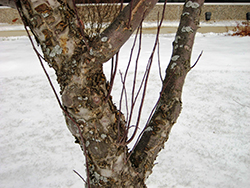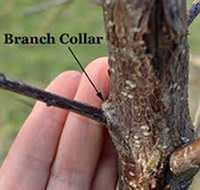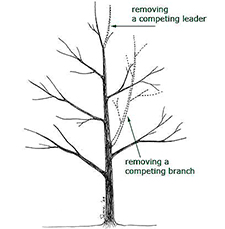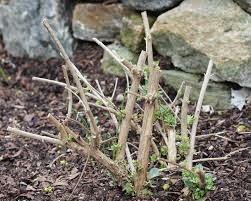
Late winter is an ideal time for pruning deciduous trees and shrubs. There’s no foliage growth yet, so the shape of the tree is easy to see — and so are any problems that need to be corrected through pruning! Pruning doesn’t need to be an overwhelming chore though. If you follow a simple checklist each year, you can keep up with this winter gardening task and keep your trees healthy. Gather your pruning tools, and let’s get started!
The three Ds: Dead, Diseased, Damaged

Begin your pruning by removing any of the three Ds — anything that’s diseased, damaged, or dead. Broken and damaged branches are more than just unsightly. They open the tree up to pests and disease. Prune back to at least 6 inches below the diseased area into healthy wood.
Removing dead branches is an obvious pruning task, but how do you know if a branch is dead or just dormant? Scrape away a small part of the bark, If it’s alive, it will be green underneath. If it’s dead, it will be hard and brown inside. You can also try the “bend test.” Bend the branch gently. A live branch will bend, but a dead branch will snap.

Water Sprouts
and Suckers
Next, look for suckers and water sprouts and remove them. Water sprouts are newer branches growing straight upwards through the tree, whereas suckers are new growth springing up around the base of the tree.
Water sprouts are caused by heavy pruning in previous years, or by stress to the tree. To prune them away, cut at the base making sure to preserve the branch collar. The branch collar is a swollen area at the base of the water sprout. Prune to about 1/2″ away from the branch collar.


Crossing and
Competing Branches
Look for branches that are not growing out from the center of the tree. These may be branches that, like water sprouts, grow straight upwards through the canopy. Also look for branches that are growing inwards towards the trunk. These branches are called competing branches because they compete for space, sun, and nutrients with healthier branches. Cut these away, so what remains are only healthy branches that are growing outwards from the main trunk.
Crossing branches are branches that grow across another. If left in place, these can rub against another branch causing damage. Removing a crossing branch ensures you won’t have to removed a damaged branch next winter!
The overall shape of the tree should be clearly visible now. Step back and look at the overall structure of the tree. If it still seems a little overcrowded in spots, prune until the shape is more even. You might want to raise the canopy a bit — that is, prune away any branches that are just too low. If there are branches that are in the way each time you mow in the summer, go ahead and remove them.
Renew an
Overgrown Shrub

For shrubs that may have become overgrown and leggy through the years, a late-winter pruning can be done to improve shape, vigor, and blooming. Prune away the oldest and weakest canes at or near the ground level. This will improve the overall height & shape and should result in more foliage and better flower quality.
NOTE: It’s crucial to do a little homework before you begin pruning. If you prune spring-blooming shrubs (think lilac, forsythia, etc.) in late winter, you’ll be cutting off this spring’s blooms! Some shrubs (like hydrangea macrophylla) bloom on “old wood,” which means last year’s new canes. If you prune out the old wood on these shrubs, you’ll cut off the canes that would be blooming this year! So, a little research will ensure you’re pruning the right shrub at the right time of year.
That’s it! If you keep up with this pruning checklist each winter, it should never become an overwhelming chore, and your trees and shrubs will be much healthier when springtime arrives.